In Rome, NPR’s Sylvia Poggioli covers crises and eats well
Leszek Hubert Bigus and Sylvia Poggioli at the Campo de’ Fiori
By Debra Samuels|GLOBE CORRESPONDENT MAY 09, 2012
ROME — Sylvia Poggioli wanted to be a Shakespearian actress. Fortuna intervened and since 1982 National Public Radio listeners have heard her syncopated sign-off, “Sylvia Po-JO-lee, NPR News, Rome.” Or Berlin. Or Paris. Or Istanbul. As senior European correspondent, Poggioli covers everything from politics to pasta, Britain to Berlusconi.
After more than 30 years here, where she lives with her husband, Piero Benetazzo, a retired foreign correspondent for a major Italian daily, Poggioli has an intimate sense of the changing city, its people, its politics, and its food. She walks or bikes everywhere — she says this is good for her health — minding the weaving cars and heaved cobblestone roads. Home is the charming Trastevere section in the center of Rome. From there, in the last three decades, she has covered the fall of the Berlin Wall, the Velvet Revolution in Czechoslovakia, the war in Bosnia, and the plight of refugees fleeing the fighting in Libya to Italy’s southernmost islands. For the past year, the European financial crisis has consumed her time. Today, she is at an outdoor market she knows well.
The correspondent grew up in Cambridge, the daughter of Italians who fled fascism in 1938. She attended Buckingham School and Harvard, then came to Rome as a Fulbright scholar, settling into her first apartment in the Campo de’ Fiori. Restaurants and bakeries ring the square, which is filled with a sprawling outdoor farmers’ market.
Campo de’ Fiori is still Poggioli’s favorite place to shop. On a sunny spring day, a street musician tightens his bow, a small group of nuns floats by in their gray habits, and Poggioli, in a long cardigan in hues of garnet and orange, with a scarf casually wrapped around her neck, heads for a vendor she knows well. Claudio Zampa, co-owner with his brother, Massimo, of Da Claudio a Campo de’ Fiori, greets Poggioli with a warm “Carissima!” They banter in Italian. Poggioli notes that the Zampa brothers’ market was in a scene in Woody Allen’s new film, “To Rome With Love.”
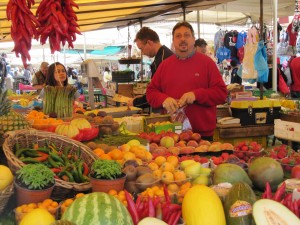
Claudio Zampa co-owner of Da Claudio a Campo De' Fiori
Tables are covered with asparagus, artichokes, peas, fava beans, lettuces, chicory, broccoli rabe, apples, oranges, strawberries, and melons. Employee Leszek Hubert Bigus who has been working here for 20 years, offers a few sprigs of dark green watercress to taste. “A bit too peppery for me,” says Poggioli. Next to a pyramid of pomegranates, burly Stefano Zampa, Claudio’s son, makes fresh juice. Poggioli explains that this was her idea because making her own juice had become tiresome. She convinced the Zampa brothers this would be popular. Now, even at 5 euros a glass (about $6.50), there is no shortage of customers.
Poggioli is so often on assignment that she doesn’t have much time to cook. When she does, her passion is vegetables. She talks about a favorite dish, vignarola, a Roman spring classic, made with vegetables in season. Massimo is selling spring onions, romaine lettuce, trimmed artichokes, shelled peas, and fava beans. “I like to use asparagus as well,” says Poggioli.
Just steps away at another stall, she stops to watch a vendor demonstrating and selling utensils that slice, dice, and make curlicues out of vegetables, something like you’d see on the Shopping Channel. “What’s your name?” asks Poggioli, who is grinning. “Ali Baba,” he quips with a straight face, before identifying himself as Ahmed Said and returning to hang zucchini curls from the ears of a delighted child. “I wanted to do a story on this guy, but you really need a video,” says Poggioli.
Romans are very proud of their unpretentious cuisine, which uses vegetables and pasta, often with few ingredients. An example is cacio e pepe, a dish of spaghetti, which is Poggioli’s favorite pasta shape, made with pecorino cheese and lots of black pepper. Food here is prepared more simply than in Emilia Romagna and the Veneto, two regions north of Rome famous for elaborate sauces and rice dishes.
Leaving the market and walking down the narrow Via dei Giubbanari, Poggioli talks about the changes in the last five years. She is concerned that the European financial crisis has led to a rise in suicides and in youth unemployment, now nearly 30 percent. Immigration from Asia, North Africa, and Eastern Europe has also risen dramatically. “There isn’t a restaurant kitchen in Rome without immigrant workers. Egyptians have been here the longest, and many have become chefs.” “Kilometer zero” — a reference to no carbon footprint when purchasing food — is a newer development. So is eating raw swordfish, tuna, and crawfish, though Poggioli does not think Italians associate it with sushi.
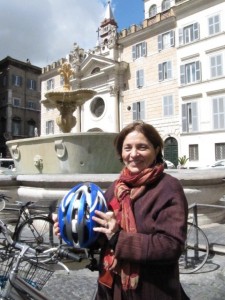
Sylvia Poggioli dons her helmet at the Piazza Farnese
At the Piazza Farnese, Poggioli returns to her parked bicycle. Work isn’t all economic downfall and politics. The journalist recalls that the silliest story she ever did was about Italian restaurants going garlic-free. She reported that Prime Minister Berlusconi’s dislike of the smell of garlic triggered a trend that came and went.
When traveling, the correspondent eats whatever is available, and sometimes she’s pleasantly surprised. She recalls a memorable pasta with a simple sauce of tomatoes and capers on the island of Linosa, off the coast of Sicily, made for her by a restaurateur who had prepared the dish for African asylum seekers.
When you get to lead a life like this, who needs Shakespeare?
Recipe for Vignarola (Italian spring vegetables)
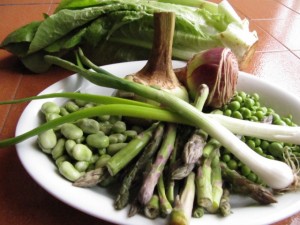
Ingredients for vignarola
Serves 6
A typically Roman springtime vegetable dish, vignarola is named for orchard workers. Sylvia Poggioli’s recipe comes from the vegetable stand Da Claudio a Campo de’ Fiori, in the heart of Rome, where she shops regularly. Similar recipes are on Italian websites. The dish begins with guanciale, a thickly sliced bacon cut from pig cheek (here we use olive oil). Cooking time depends on the quality of vegetables; if they are very fresh, the dish should be ready in about 30 minutes. Once cooked, the bright green colors turn into a more subtle hue.
2 tablespoons olive oil
3 spring onions, sliced
1 head romaine lettuce, cut into thin strips
4 artichokes, trimmed, chokes thinly sliced
Salt and pepper, to taste
½ cup water
⅔ pound fava beans, shelled (to make 1½ cups)
1½ cups fresh or frozen peas
1 bunch asparagus, trimmed, stalks cut into thirds
Extra olive oil (forsprinkling)
1. In a large skillet over low heat, heat the olive oil. Add the scallions and cook, stirring, for 3 minutes. Add the lettuce, artichokes, salt, pepper. Add ¼ cup water and cover the pan. Simmer over medium-low heat for about 8 minutes, adding more water if the mixture seems dry.
2. Add the fava beans and cook, stirring often, for 5 minutes. Add the peas and asparagus. Cook 5 minutes more, stirring occasionally, or until all the vegetables are tender. Add more water to the pan if it seems dry.
3. With a slotted spoon, transfer the vegetables to a serving dish. Sprinkle with olive oil. Taste for seasoning and add more salt and pepper, if you like. Serve warm. Adapted from Sylvia Poggioli

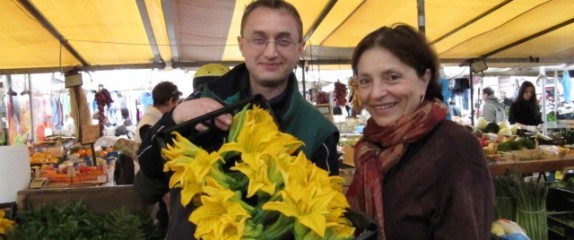
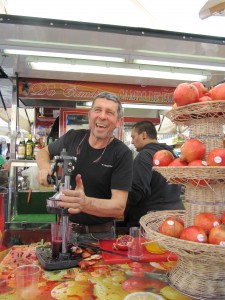
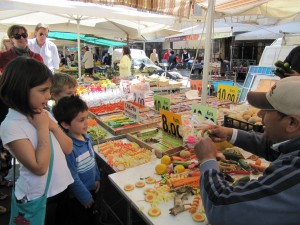









 Debra Samuels, bestselling author, food writer and cooking instructor,
Debra Samuels, bestselling author, food writer and cooking instructor, 


